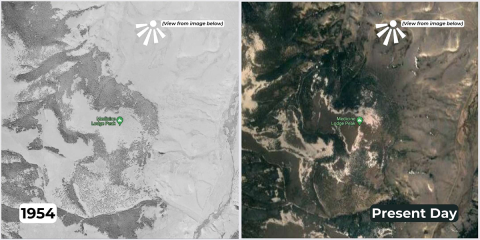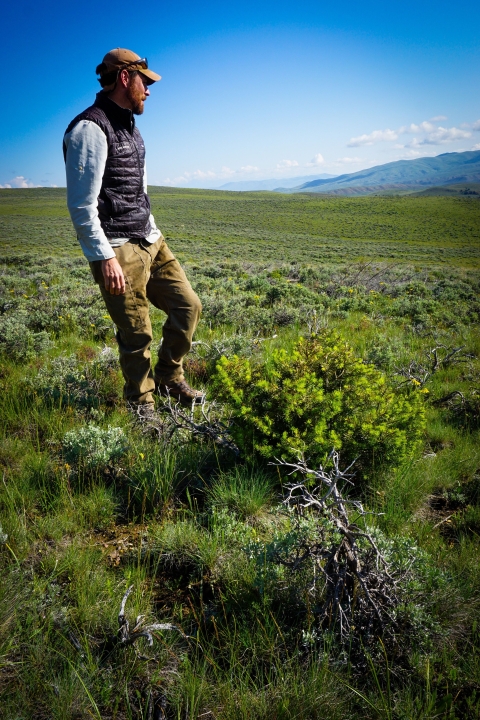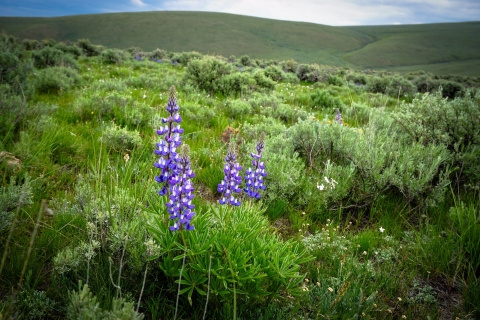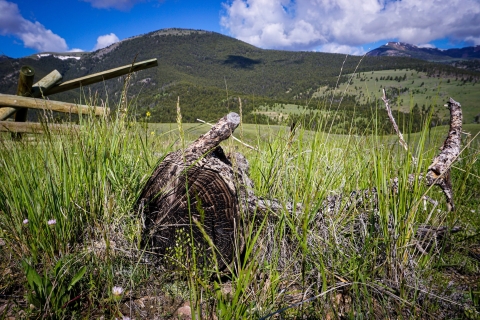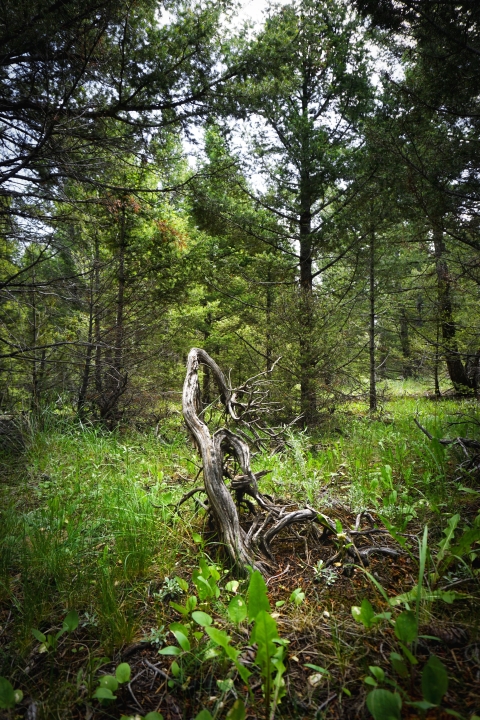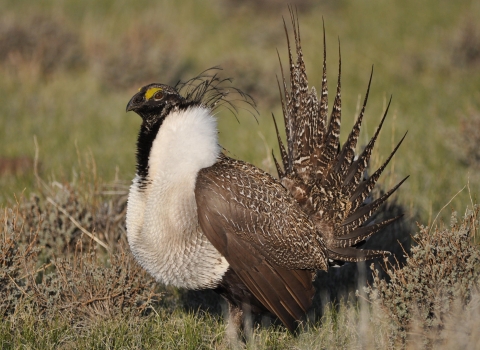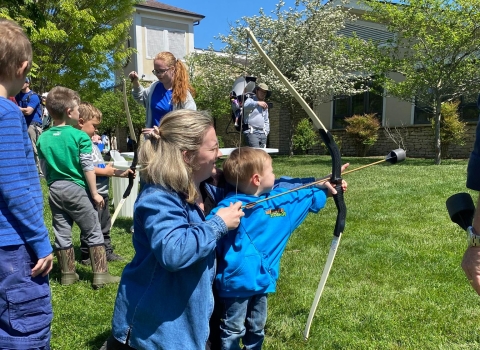The following story was written by partners at the Intermountain West Joint Venture and the original version * is available on their Partnering to Conserve Sagebrush Rangelands website.
*When you use the above link, you are leaving the USFWS website. DOI and the bureaus do not guarantee that outside websites comply with Section 508 (Accessibility Requirements) of the Rehabilitation Act. Links also do not constitute endorsement, recommendation, or favoring by the U.S. Fish and Wildlife Service.
✦ ✦ ✦
In June, the spider web of mountains and valleys that traverse Beaverhead County in southwest Montana are in a full bloom of wildflowers. In this high, cold place in the northern Rockies, the longest river system in the United States emerges from the meltwater that seeps off the mountainsides in this season—especially this year, after an abnormally wet Spring. The air is crisp and clear, the hillsides lush and gray-green with sagebrush sagebrush
The western United States’ sagebrush country encompasses over 175 million acres of public and private lands. The sagebrush landscape provides many benefits to our rural economies and communities, and it serves as crucial habitat for a diversity of wildlife, including the iconic greater sage-grouse and over 350 other species.
Learn more about sagebrush shrubs and, higher up, dark green with stands of Douglas fir and juniper trees.
And amidst this landscape, under the enormous blue bell of a sky scraped by mountains, Sean Claffey shakes his head in disappointment at a baby tree.
Claffey is the Conservation Coordinator for the Southwest Montana Sagebrush Partnership (SMSP)*, and a Sage Capacity Team member representing Partnering to Conserve Sagebrush Rangelands, a conservation effort between the Intermountain West Joint Venture (IWJV) and the Bureau of Land Management (BLM).
This three-foot-tall Douglas fir has grown here within the past couple of years, despite the best efforts of a coalition of federal, state, and local agencies to stop it.
“They’re not a surprise,” Claffey said of the sapling. “Honestly, what I see here is opportunity.”
Claffey and his colleagues working in sagebrush conservation have nothing against trees like this little Douglas fir, and Western conifer forests are important habitat in their own right. But Claffey and other members of the SMSP are attempting to combat a problem that conifer trees like this present in southwest Montana and across the West: a slow invasion into neighboring sagebrush shrubland, which is home to many sagebrush-obligate species including the Greater Sage-grouse.
“We’re seeing site conversion of sagebrush steppe, essentially,” said Greg Schenk, Fire Management Specialist at the BLM field office in nearby Dillon, MT, and Claffey’s close collaborator. “It’s pretty drastic when you look at old aerial imagery from the 1950s. For example, in some places where we used to have sage and grass parks intermixed with conifer woodland, we now see 50-70% of those parks overgrown by conifer expansion. Trees have filled in those areas.”
This young Douglas fir has sprouted in one of the 45,000 acres of historic sagebrush rangeland that the SMSP has treated for conifer encroachment since the partnership’s inception in 2018. Their working group is one of many across the West that will benefit from infusions of funding from Biden Administration investments like the Bipartisan Infrastructure Law and Inflation Reduction Act. This funding is instrumental in the effort to keep sagebrush ecosystems from being overtaken by trees as they grow further down mountain slopes.
Typically, young invading conifers are removed using mechanical means: teams with chainsaws and earth-moving vehicles are deployed to prune trees back into their historic ranges, giving native shrubs and perennial grasses a chance to thrive once more. But in cooler and wetter sites, like those in portions of southwest Montana, trees often start to grow back within a few years after the treatments take place.
Claffey diagnoses the problem in this particular plot in an instant. The mechanical removal of conifers that occurred here was successful, yes. But this plot, unlike others, was not burned afterwards.
“It’s really evident in this region that when we use mechanical means only—no matter how good a job the crew does—at some sites we see conifer regeneration above the sagebrush canopy height within five to ten years,” Claffey said. “All it takes is for one branch on one tree to survive.”
In this landscape, this problem can be addressed by following up the initial mechanical treatments with prescribed fire, also known as controlled burns. In service of their collective ecosystem restoration goals, the SMSP is currently teaming up with the BLM Fuels Program to implement controlled burns in springtime, after mechanical removal of conifers. Significant progress has also been made to work with partners like the Montana Department of Natural Resources and Conservation to scale up the use of prescribed fire across all land ownerships.
“It’s a pretty stark difference in the success of the projects,” Claffey said. “When you walk through an area that’s been burned, there’s no conifer regeneration. The seed source from those conifers, those saplings, was all consumed in the fire. The only thing you see coming up is forbs, native perennial bunchgrasses, and, within a year or two, baby sagebrush. But you walk out of that to a plot where you haven’t seen fire, and it’s almost overwhelming, the amount of Douglas fir seedlings.”
This stark difference in outcomes hints at the ecological history of sagebrush steppe, conifer woodlands, and the ever-flexing boundary between them. Before the era of European colonization, low-intensity wildfires were frequent in this region of Montana, with fire occurring on average every 35 to 40 years. This high fire frequency regularly cleansed the boundary of sagebrush steppe and grasslands of young trees, restarting the clock of ecological succession while returning nutrients to the soil.
Additionally, indigenous communities stewarded this process by managing prescribed burns, for a variety of ecological and social benefits, for thousands of years. But in the late 1800s European settlers began suppressing wildland fires, and historic tribal fire management practices were also disrupted as part of the forced removal of Native people from many parts of Montana. In this post-settlement era, wildland fire has been rendered much less frequent—and one of the effects is that sagebrush rangelands are yielding to encroaching conifer woodlands.
“We’re restoring a natural process that would have kept conifers and forests in their historic range,” Claffey said of SMSP’s prescribed burn prescribed burn
A prescribed burn is the controlled use of fire to restore wildlife habitat, reduce wildfire risk, or achieve other habitat management goals. We have been using prescribed burn techniques to improve species habitat since the 1930s.
Learn more about prescribed burn management in collaboration with BLM Fire. “We’re at the ecotone between high elevation moist sagebrush and low elevation dry forests. It turns out that they’re both fire-adapted ecosystems.”
The use of prescribed burning as a tool to mitigate conifer encroachment into sagebrush rangelands has been a topic of extensive research, and even controversy. The effects of fire in sagebrush ecosystems vary greatly depending on an array of factors including climate, the region’s temperature and levels of moisture, elevation, the composition of the plant community and the soil’s seed bank, the presence of invasive species invasive species
An invasive species is any plant or animal that has spread or been introduced into a new area where they are, or could, cause harm to the environment, economy, or human, animal, or plant health. Their unwelcome presence can destroy ecosystems and cost millions of dollars.
Learn more about invasive species , and more.
In many neighboring regions—including Nevada’s Great Basin, southwest and considerably downslope of Montana’s High Divide Headwaters region—researchers and land managers caution against the use of fire in sagebrush rangelands. The climate is warm, dry, and arid, and the locally dominant species of sagebrush—Wyoming big sagebrush (Artemesia tridentata var. wyomingensis) and basin big sagebrush (Artemesia tridentata var. tridentata)—can take between 50 and 200 years to regenerate after fire. This leaves rangelands susceptible to takeover by invasive annual grasses like cheatgrass, which can be a death knell for the ecosystem resulting in plummeting biodiversity and frequent, intense wildfires as a monoculture of flammable invasive grass establishes itself.
But the sagebrush ecosystem, while imperiled, is also vast, and it is not a monolith.
“That’s something that’s eye-opening to a lot of folks—I know it was for me!” Claffey said. “Sagebrush isn’t just sagebrush! In southwest Montana alone there are thirteen species and subspecies of sagebrush, each in their own niches and habitats, preferred precipitation levels, and preferred soil types.”
In the high mountains and valleys of southwest Montana, mountain big sagebrush (Artemesia tridentata var. vaseyana)—rather than Wyoming big sagebrush, or basin big sagebrush—dominates. This species thrives in this cool, moist, high-elevation landscape, and regenerates from fire on average within about 30 years. And ironically, because this mountain sagebrush-dominated ecosystem is historically dependent on the disturbance of fire, land managers believe that low-intensity burns here can actually make the system more resilient to the influx of invasives like cheatgrass.
Given the array of factors that contribute to ecological change, it can be difficult for researchers to pin down a clear answer to cut-and-dried, yes-or-no questions about best practices in ecological management across biomes. That’s especially true when those questions consider what effects a management decision like implementing a prescribed burn will have on the landscape in 25, 50, or 100 years. But the local knowledge and long-term memory of on-the-ground observation by landowners and managers can sometimes amount to a wealth of decision-making power.
Having seen the outcomes of the prescribed burns he manages with BLM Fire time and time again, Schenk has observed the flush of growth that emerges when fire resets the successional clock in southwest Montana sagebrush.
“There are the first-order effects the day after the fire: It’s all black, right?” Schenk said. “But you just wait: Two weeks, and lo and behold, those spring rains come in. We start seeing grass. Then we start seeing lupine and other flowers and forbs: the purples, the yellows, this complete array of biodiversity. In the following years it just gets more and more full.”
And according to Claffey and Schenk’s observations, this trend continues for years after a low-intensity prescribed burn. Biodiversity flourishes—and, importantly, the recurrence of young conifers is markedly delayed.
“With the use of fire we can expect 50 years or more of this treatment effect of conifer reduction,” said Claffey. “Whereas using chainsaws or mechanical means alone, you may only have about 25 years until the conifers return to the same canopy cover as when you started.”
Ecosystem restoration is all about balance: No treatment lasts forever. Boundaries of ecosystems like sagebrush rangelands and conifer woodlands grow and shrink over hundreds of years like the slow movement of a breath, dependent on long-term trends like climate change climate change
Climate change includes both global warming driven by human-induced emissions of greenhouse gases and the resulting large-scale shifts in weather patterns. Though there have been previous periods of climatic change, since the mid-20th century humans have had an unprecedented impact on Earth's climate system and caused change on a global scale.
Learn more about climate change . Land managers are charged with the difficult task of determining what will be the best practice for stewardship of a landscape now—within the short scope of one person’s life, one person’s career.
On this clear June day in southwest Montana, Claffey climbs slightly higher up slope, away from the recent mechanical treatment plot where tiny Douglas fir saplings are thrusting their three-foot crowns up past the tops of neighboring sagebrush, winning the battle of ecological succession in a fire-suppressed rangeland. He climbs from knee-high shrubland and into the woodland proper. Established Douglas fir trees tower overhead, and their distinctive feathered cones crunch underfoot.
It may feel like this near-silent woodland has been here for eternity, but the understory tells a different tale. The shade of these towering trees is littered with the gnarled skeletons of dead sagebrush that once dominated here. A mere 50 years ago, this was a sagebrush rangeland. The trees have overtaken them.
Across the West, as biomes slowly wax and wane with the passage of time, decisive action in our lifetimes informed by the wisdom of locals—and aided by working coalitions like the SMSP—can help to keep habitats and landscapes in balance, working for wildlife and people for generations to come.
“If we’re truly working on an ecosystem, we can’t remove humans from that,” Claffey concluded. “Part of the ecosystem is our stewardship.”
✦ ✦ ✦
*SMSP members include the U.S. Fish and Wildlife Service Partners for Fish and Wildlife Program, U.S. Bureau of Land Management, Beaverhead Conservation District, Ruby Watershed Council, Big Hole Watershed Committee, The Nature Conservancy, Montana Fish, Wildlife and Parks, Heart of the Rockies Initiative, National Wildlife Federation, Montana Department of Natural Resources and Conservation, U.S. Forest Service - Beaverhead-Deerlodge National Forest, and the U.S. Department of Agriculture’s Natural Resources Conservation Service.
The Southwest Montana Sagebrush Partnership is just one of many productive conservation partnerships working West-wide to maintain core sagebrush habitat in the face of threats like conifer encroachment and invasive annual grass establishment. To learn more about these efforts, visit www.PartnersInTheSage.com. And to learn more about how investments like the Bipartisan Infrastructure Law Bipartisan Infrastructure Law
The Bipartisan Infrastructure Law (BIL) is a once-in-a-generation investment in the nation’s infrastructure and economic competitiveness. We were directly appropriated $455 million over five years in BIL funds for programs related to the President’s America the Beautiful initiative.
Learn more about Bipartisan Infrastructure Law and Inflation Reduction Act are assisting these efforts, click here.


